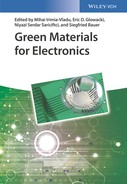Book Description Combining the materials science, technological, and device aspects of organic bioelectronics based on green materials, this is the first overview of the emerging concepts involving fabrication techniques for sustainable electronics with low energy and material consumption. Show and hide more
Table of Contents
Cover Title Page Copyright List of Contributors Preface Chapter 1: Emerging “Green” Materials and Technologies for Electronics 1.1 Introduction to “Green” Materials for Electronics 1.2 Paper 1.3 DNA and Nucleobases 1.4 Silk 1.5 Saccharides 1.6 Aloe Vera, Natural Waxes, and Gums 1.7 Cellulose and Cellulose Derivatives 1.8 Resins 1.9 Gelatine 1.10 Proteins, Peptides, Aminoacids 1.11 Natural and Nature-Inspired Semiconductors 1.12 Perspectives References Chapter 2: Fabrication Approaches for Conducting Polymer Devices 2.1 Introduction 2.2 Photolithography 2.3 Printing 2.4 Conclusions References Chapter 3: Biocompatible Circuits for Human–Machine Interfacing 3.1 Introduction 3.2 Ion Transport Mechanisms 3.3 Organic Electronic Ion Pump 3.4 Ion Diodes, Transistors, and Circuits 3.5 Conclusions References Chapter 4: Biocompatible Devices and Sustainable Processes for Green Electronics: Biocompatible Organic Electronic Devices for Sensing Applications 4.1 Introduction 4.2 Fundamental Aspects of OTFT Sensors 4.3 OTFT: Sensing Applications 4.4 OTFTs: Biosensors 4.5 Conclusions References Chapter 5: Biocompatible Materials for Transient Electronics 5.1 Introduction 5.2 Mechanisms of Dissolution of Monocrystalline Silicon Nanomembranes (Si NMs) 5.3 Dissolution Mechanisms of Transient Conductors and Insulators 5.4 Tunable/Programmable Transience 5.5 Transient Electronic Systems 5.6 Functional Transformation via Transience 5.7 Biocompatiblity and Bioresorption 5.8 Practical Applications in Medical Implants 5.9 Conclusions References Chapter 6: Paper Electronics 6.1 Introduction 6.2 Paper as a Substrate for Electronics 6.3 Application Areas for Paper Electronics 6.4 Green Electronics on Paper 6.5 Paper-Based Analytical Devices and Test Platforms 6.6 Summary and Future Outlook References Chapter 7: Engineering DNA and Nucleobases for Present and Future Device Applications 7.1 The Versatile World of Nucleic Acids 7.2 Nucleic Acids in Electronics 7.3 Nucleic Acids in Nanotechnology 7.4 DNA Molecular Engineering 7.5 Summary and Future Outlook Acknowledgments References Chapter 8: Grotthuss Mechanism: From Proton Transport in Ion Channels to Bioprotonic Devices 8.1 Introduction 8.2 Proton Wires: Chains of Hydrogen Bonds and Grotthuss Mechanisms 8.3 Proton Transport in Proton Channels 8.4 Proton Transport across Membranes and Oxidative Phosphorylation 8.5 Biopolymer Proton Conductors 8.6 Devices Based on Proton Conductors 8.7 Bioprotonic Devices: Diodes, Transistors, Memories, and Transducers 8.8 Future Outlook Acknowledgments References Chapter 9: Emulating Natural Photosynthetic Apparatus by Employing Synthetic Membrane Proteins in Polymeric Membranes 9.1 Introduction 9.2 Light-Harvesting Complex II 9.3 Natural Proteins in Natural Membrane Assemblies 9.4 Plant-Inspired Photovoltaics: The Twenty-First Century and Beyond References Chapter 10: Organic Optoelectronic Interfaces for Vision Restoration 10.1 Introduction 10.2 Retinal Implants for Vision Restoration 10.3 Perspectives References Chapter 11: Nanostructured Silica from Diatoms Microalgae: Smart Materials for Photonics and Electronics 11.1 Diatoms: Living Cells in Glass Houses 11.2 Diatom Frustules in Photonics and Optics 11.3 Diatom Frustules in Electronics 11.4 Conclusions Acknowledgments References Index End User License Agreement
